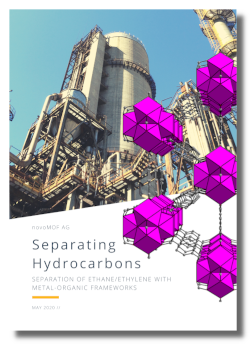Cryogenic distillation technology is still leading the gas separation processes in the chemical industry. However, some applications in the manufacturing of chemicals, energy generation, and environmental fields have been proposed for the use of new separation technologies. More recent material developments offer new routes to tackle challenges.
For a couple of decades now, membrane-based separations have been considered a viable option in the replacement of distillation as they offer chemical resistance, stability, and low cost. Membrane materials like silica, zeolites, and carbon based material are widely used. Some important separations in the aforementioned fields include the purification of He from hydrocarbon mixtures, H2/CO2 separation for hydrogen production, and CO2/N2 separation for greenhouse gas capture. On these examples, we want to compare silica and metal-organic frameworks (MOFs). While we usually compare the raw material – powders in most cases – silica has shown low performance in contrast to silica membranes. This article is thus evaluating silica and MOF-membranes, you can find a large article on gas separations with MOFs here.
Gas separation using membrane technology
The gas separation in membrane technology works based on the permeation mechanisms, which depend on the pore sizes. For a pore size less than 0.1 µm, the permeation by diffusion is the main mechanism, where small molecules move faster than big ones (also a combination with adsorption can be used to increase the selectivity of the membrane). If the pore size range from 0.5 to 20 nm, then the separation is made by molecular sieving.
Usually, two parameters, permeance and selectivity, define the performance of a membrane in gas separations. The permeance (or permeation) estimates the transport rate of molecules through the membrane, and the selectivity evaluates the ability of the membrane to separate components of a mixture. The desirable properties for membranes are a combination of high permeation rate, species selectivity, mechanical, chemical, and thermal stability under real operating conditions.
Silica membranes: Pro’s and Con’s
Silica is one of the most studied membrane materials for gas separation. While Silica has been used as powder for gas separation, the separation performance was poor. However, silica-based membranes can offer good perm-selectivity at high temperatures making them attractive for its application on industrial processes. Due to its hydrophilic nature, regular silica materials are susceptible to water absorption making them have poor hydrothermal stability. This problem was addressed by the functionalization with different organic groups showing hydrothermal stability improvements. Another approach was to create composites with different materials.
Besides functionalization, other factors in the fabrication of silica-based membranes need to be considered when designing for a specific application. For instance, in membrane synthesis, the pore size and structure depends on the method used. The most popular methods include sol-gel coating, chemical vapor deposition, chemical vapor infiltration, precursor polymer pyrolysis, atomic layer deposition, and catalytic atomic layer deposition. The wide variety of methods makes it difficult to predict the properties of a membrane especially regarding pore structure; therefore, the membrane design is not a simple task.
Hybrid materials changing membranes
Metal-Organic Frameworks (MOFs) are hybrid inorganic-organic materials showing promising results as gas separation technology since they have a well-defined pore size and shape. In the case of MOFs, they can be used as membrane material but also as filling material in packed beds. In contrast to most membrane material, MOFs have the advantage that they can be synthesized easily in a controlled manner. The large variety of MOFs available and its facile synthesis can increase the selectivity of the membranes.
We have a case study on challenging gas separations, that you might like:
Hydrogen separation a challenging process for membranes
Within the most relevant applications is the H2 separation. Hydrogen is considered one of the most important alternative fuel and its production from steam reformed natural gas (or ethanol) generate a mixture containing CO2. This reaction is carried out at high temperatures (350 °C or higher), which makes it a very challenging process for membrane-based technologies. However, MOF CAU-10-H-based membranes have shown good hydrothermal stability alongside with good selectivity (11.1 selectivity factor over CO2) after long-term tests. On the other hand, microporous silica membranes that have been tested showed good selectivity for hydrogen. However, they lack hydrothermal stability losing selectivity for hydrogen, even when they were modified to increase stability.
In recent advances, MOFs materials were used to create novel 2D nanosheets, to increase the selectivity of the materials based on the premise that the main separation mechanism is molecular sieving. The authors say these nanosheets allows to have the sieving and adsorption properties of the bulk phase of the MOFs. The results of this ultrathin membrane showed a >200 selectivity for hydrogen over CO2 with permeance as high as 3,760 gas permeation units.
Conclusions
Membrane-based separation is a promising technology that can offer advantages in terms of low energy consumption, smaller carbon footprint, and easy operation. Membrane properties (such as permeation and selectivity) are dependent on the physical and chemical properties of the material including the microstructures of the membrane/support, pore size and distribution, porosity, and the affinity between permeating species and the pore walls. Since the separation of a gas mixture relay on differences in molecular mass, size or shape, or on differences in the affinity of the gas molecules to the membrane material, MOFs seems to be the most promising materials for membranes due to their easy tuning in pore size and shape as well as their ability to change chemical properties.






